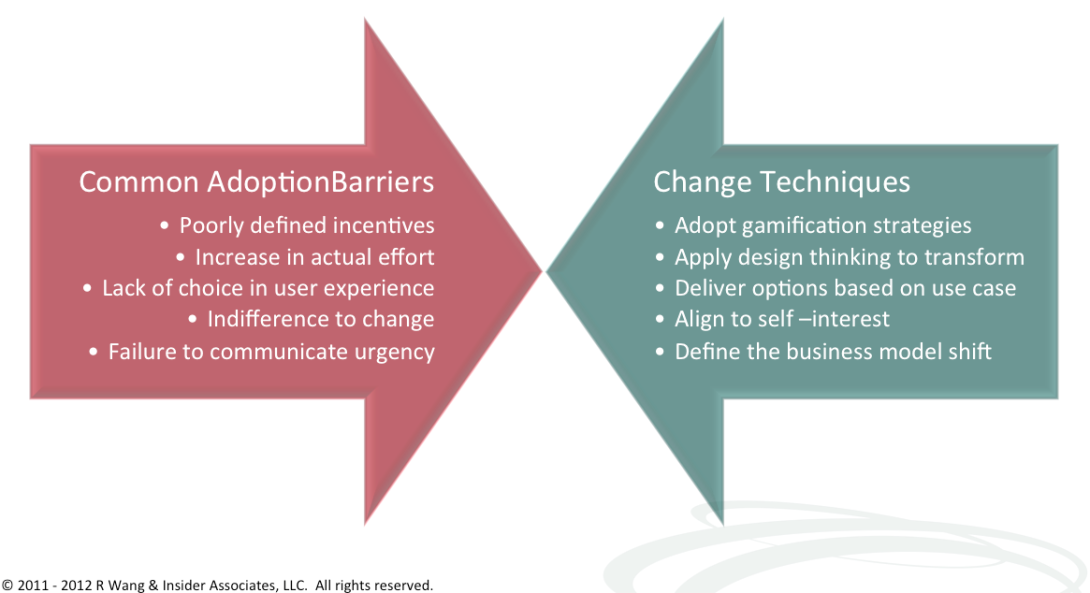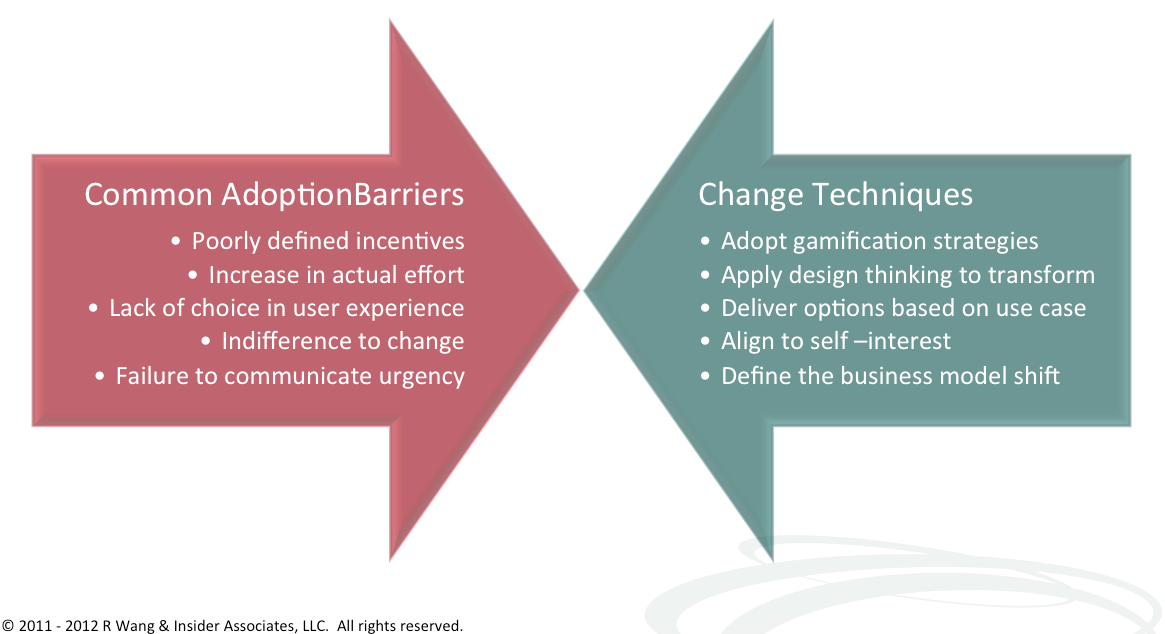
Tuesday's Tip: Dealing With The Real Problem In Social Business Adoption - The People!

Social Business Adoption Dependent On Employee Adoption
Social business is more than a technology decision. Many eager early adopters face challenges in adoption past the initial core team. As we move from eager early adopters to ubiquitous usage, an examination of some organizations who have failed at internal social business reveals five common barriers to adoption:
- Poorly defined incentives. In the rush to convince everyone to work with each other, most organizations fail to design meaningful incentives for adoption. The reality - most folks collaborate only when they need to, not when they are told to.
- Increase in actual effort. For many in the workforce, collaboration often means more work, not less work. Connectedness results in more interactions, some less meaningful than others. Increase in effort often shifts the status quo resulting in internal resistance.
- Lack of choice in user experience. Time and time, people want to use the tool they are most comfortable with. For example, activity streams make sense for some folks who are used to high frequency, always on, information flows. However, those accustomed to using email as a task list and structured approach to filing information will find discomfort with activity streams.
- Indifference to change. Inertia to do nothing often outweighs the calls for change. The workforce often prefers to do things the way they always have been. The workforce has seen many changes and at this point face change fatigue.
- Failure to communicate the urgency. Business model shifts are not easy to communicate to the workforce. Veteran employees often develop coping mechanisms that define the new change as a reincarnation of the old change without understanding the nuance or urgency.
Overcoming Barriers Of Adoption Require A Mix of New and Classical Change Management Techniques
Despite compelling benefits to achieve better collaboration among teams, improved engagement among the workforce, and faster speed of internal communication, adoption efforts require careful design. As with any organizational change, it's the people, stupid! The five barriers can be countered with the following five strategies (see Figure 1.):
-
Adopt gamification strategies. Listen for both the monetary and non-monetary incentives. Design a hierarchy and weighting of incentives to effort. Use gamification techniques to improve adoption and internal engagement.
-
Apply design thinking to transform. Use design thinking scenarios to ideate future state processes. Remove friction points and redundant processes so that interaction is natural. Stamp areas where extra effort emerges.
-
Deliver options based on use case. Identify cohorts and preferences in communication and cultural styles. Apply the 9Cs of engagement to deliver the right user experience strategy. Provide multiple interface choices as well as educate on new user experience metaphors.
-
Align to self –interest. Show the workforce where and how the benefits apply to the individual. Highlight the overall group advantages. Providing the connection between individual and group benefits often plays a powerful lever in effecting change.
-
Define the business model shift. For quant jocks, apply a financial business model. For poets, highlight the narrative in the shift and communicate the overall transformation at hand.
Figure 1. Overcoming the Barriers of Social Business Adoption
The Bottom Line: Apply Change Management And Design Thinking To Improve Social Business Adoption
While technology plays a key role in improving social business, core change management principles still must be applied to ensure organizational transformation. Technology alone will not solve the issue. A combination of design thinking techniques applied to change management will ensure more successful adoption rates. Planning for change management will require as much time as the technical implementation. Consequently, successful social business efforts incorporate both technology and change management work streams in concert with each other.
Your POV.
Ready to fight change management and adoption head on? Have a story on how you’ve achieved engagement? Add your comments to the blog or send us a comment at R (at) SoftwareInsider (dot) org or R (at) ConstellationRG (dot) com
Please let us know if you need help with your Social CRM/ Social Business efforts. Here’s how we can assist:
- Assessing social business/social CRM readiness
- Developing your social business/ social CRM strategy
- Vendor selection
- Implementation partner selection
- Connecting with other pioneers
- Sharing best practices
- Designing a next gen apps strategy
- Providing contract negotiations and software licensing support
- Demystifying software licensing
Related Research:
- Monday’s Musing: Avoiding Social Media Fatigue Through Engagement
- Friday’s Features: Using Attensity Analyze 6.0 To Compare Customer Sentiment For @united @southwestair @virginamerica
- Event Report: Lithium Network Conference 2012 #LiNC
- Best Practices: From First To Worst – Continental In A Post United World, Lessons In Next Gen Customer Experience
- Monday’s Musings: Seven Basic Privacy Rights Users Should Demand For Social Business
- News Analysis: Lithium Technologies Adds $53M in Financing
- Monday’s Musings: Balancing The Six S’s In Consumerization Of IT
- Monday’s Musings: A Working Vendor Landscape For Social Business
- Product Review: Google+, Consumerization of IT, and Crossing The Chasm For Enterprise Social Business
- Monday’s Musings: Using MDM To Build A Complete Customer View In A Social Era
- Monday’s Musings: Mastering When and How High End Brands Should Use Daily Deal Sites Such As Groupon
- News Analysis: Salesforce.com Acquires Radian6 For $316M
- Monday’s Musings: Q1 2011 State of Social CRM and CRM From An EMEA Point Of View
- Best Practices: Applying Social Business Challenges To Social Business Maturity Models
- Research Summary: Software Insider’s Top 25 Posts For 2010
- Best Practices: Five Simple Rules For Social Business
- Research Report: Constellation’s Research Outlook For 2011
- Research Report: How The Five Pillars Of Consumer Tech Influence Enterprise Innovation
- Research Report: Next Gen B2B and B2C E-Commerce Priorities Reflect Macro Level Trends
- News Analysis: Jive Fills Warchest, Ready to Battle Enterprise Software Giants And IPO?
- Tuesday’s Tip: Applying The Five Stages Of Adoption Towards SCRM Projects
- News Analysis: Lithium’s Acquisition of Scout Labs Ups The Ante in Social CRM
- News Analysis: Biz360 Acquisition Signals Attensity Group’s Move Into Social CRM
- Monday’s Musings: Avoiding Failure In Social CRM Projects Requires Ecosystem Coordination
- Research Report: The 18 Use Cases of Social CRM – The New Rules of Relationship Management
- News Analysis: Siperian Acquisition Vaults Informatica Into An MDM Leadership Position
- News Analysis: Jive and Radian6 Partner – Great For Business, But Could Fragment IT Systems
- Event Report: Salesforce.com Pushes Social CRM Technology — But Don’t Expect Companies To Be Successful With Tools Alone
- Monday’s Musings: Why Every Social CRM Initiative Needs An MDM Backbone
- Personal Log: Altimeter Group – Helping Organizations Bridge The Technology Obsolescence Gap
- Monday’s Musings: 10 Essential Elements For Social Enterprise Apps
Reprints
Reprints can be purchased through Constellation Research, Inc. To request official reprints in PDF format, please contact Sales .
Disclosure
Although we work closely with many mega software vendors, we want you to trust us. For the full disclosure policy, stay tuned for the full client list on the Constellation Research website.
* Not responsible for any factual errors or omissions. However, happy to correct any errors upon email receipt.
Copyright © 2001 – 2012 R Wang and Insider Associates, LLC All rights reserved.
Contact the Sales team to purchase this report on a a la carte basis or join the Constellation Customer Experience!
 R "Ray" Wang
R "Ray" Wang R "Ray" Wang
R "Ray" Wang